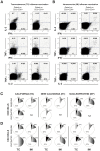Preferential amplification of CD8 effector-T cells after transcutaneous application of an inactivated influenza vaccine: a randomized phase I trial
- PMID: 20520820
- PMCID: PMC2877091
- DOI: 10.1371/journal.pone.0010818
Preferential amplification of CD8 effector-T cells after transcutaneous application of an inactivated influenza vaccine: a randomized phase I trial
Abstract
Background: Current conventional vaccination approaches do not induce potent CD8 T-cell responses for fighting mostly variable viral diseases such as influenza, avian influenza viruses or HIV. Following our recent study on vaccine penetration by targeting of vaccine to human hair follicular ducts surrounded by Langerhans cells, we tested in the first randomized Phase-Ia trial based on hair follicle penetration (namely transcutaneous route) the induction of virus-specific CD8 T cell responses.
Methods and findings: We chose the inactivated influenza vaccine - a conventional licensed tetanus/influenza (TETAGRIP) vaccine - to compare the safety and immunogenicity of transcutaneous (TC) versus IM immunization in two randomized controlled, multi-center Phase I trials including 24 healthy-volunteers and 12 HIV-infected patients. Vaccination was performed by application of inactivated influenza vaccine according to a standard protocol allowing the opening of the hair duct for the TC route or needle-injection for the IM route. We demonstrated that the safety of the two routes was similar. We showed the superiority of TC application, but not the IM route, to induce a significant increase in influenza-specific CD8 cytokine-producing cells in healthy-volunteers and in HIV-infected patients. However, these routes did not differ significantly for the induction of influenza-specific CD4 responses, and neutralizing antibodies were induced only by the IM route. The CD8 cell response is thus the major immune response observed after TC vaccination.
Conclusions: This Phase Ia clinical trial (Manon05) testing an anti-influenza vaccine demonstrated that vaccines designed for antibody induction by the IM route, generate vaccine-specific CD8 T cells when administered transcutaneously. These results underline the necessity of adapting vaccination strategies to control complex infectious diseases when CD8 cellular responses are crucial. Our work opens up a key area for the development of preventive and therapeutic vaccines for diseases in which CD8 cells play a crucial role.
Trial registration: Clinicaltrials.gov NCT00261001.
Conflict of interest statement
Figures



Similar articles
-
Randomized Controlled Trial to Compare Immunogenicity of Standard-Dose Intramuscular Versus Intradermal Trivalent Inactivated Influenza Vaccine in HIV-Infected Men Who Have Sex With Men in Bangkok, Thailand.Clin Infect Dis. 2016 Feb 1;62(3):383-391. doi: 10.1093/cid/civ884. Epub 2015 Oct 20. Clin Infect Dis. 2016. PMID: 26486702 Free PMC article. Clinical Trial.
-
Safety, tolerability, and immunogenicity of influenza vaccination with a high-density microarray patch: Results from a randomized, controlled phase I clinical trial.PLoS Med. 2020 Mar 17;17(3):e1003024. doi: 10.1371/journal.pmed.1003024. eCollection 2020 Mar. PLoS Med. 2020. PMID: 32181756 Free PMC article. Clinical Trial.
-
Safety, tolerability, acceptability and immunogenicity of an influenza vaccine delivered to human skin by a novel high-density microprojection array patch (Nanopatch™).Vaccine. 2018 Jun 18;36(26):3779-3788. doi: 10.1016/j.vaccine.2018.05.053. Epub 2018 May 17. Vaccine. 2018. PMID: 29779922 Clinical Trial.
-
Basics of CD8 T-cell immune responses after influenza infection and vaccination with inactivated or live attenuated influenza vaccine.Expert Rev Vaccines. 2018 Nov;17(11):977-987. doi: 10.1080/14760584.2018.1541407. Epub 2018 Nov 15. Expert Rev Vaccines. 2018. PMID: 30365908 Review.
-
Distinct and complementary roles of CD4 T cells in protective immunity to influenza virus.Curr Opin Immunol. 2018 Aug;53:13-21. doi: 10.1016/j.coi.2018.03.019. Epub 2018 Apr 2. Curr Opin Immunol. 2018. PMID: 29621639 Free PMC article. Review.
Cited by
-
In planta Production and Validation of Neuraminidase Derived from Genotype 4 Reassortant Eurasian Avian-like H1N1 Virus as a Vaccine Candidate.Plants (Basel). 2022 Nov 4;11(21):2984. doi: 10.3390/plants11212984. Plants (Basel). 2022. PMID: 36365437 Free PMC article.
-
Protective CD8 T cell-mediated immunity against influenza A virus infection following influenza virus-like particle vaccination.J Immunol. 2013 Sep 1;191(5):2486-94. doi: 10.4049/jimmunol.1300954. Epub 2013 Jul 24. J Immunol. 2013. PMID: 23885108 Free PMC article.
-
Skin immunization with influenza vaccines.Curr Top Microbiol Immunol. 2015;386:343-69. doi: 10.1007/82_2014_407. Curr Top Microbiol Immunol. 2015. PMID: 25038939 Free PMC article. Review.
-
Recent advances in epicutaneous immunotherapy and potential applications in food allergy.Front Allergy. 2023 Oct 27;4:1290003. doi: 10.3389/falgy.2023.1290003. eCollection 2023. Front Allergy. 2023. PMID: 37965375 Free PMC article. Review.
-
Vaccination into the Dermal Compartment: Techniques, Challenges, and Prospects.Vaccines (Basel). 2020 Sep 16;8(3):534. doi: 10.3390/vaccines8030534. Vaccines (Basel). 2020. PMID: 32947966 Free PMC article. Review.
References
-
- Wharton M, Strikas RA, Harpaz R, Rotz LD, Schwartz B, et al. Recommendations for using smallpox vaccine in a pre-event vaccination program. Supplemental recommendations of the Advisory Committee on Immunization Practices (ACIP) and the Healthcare Infection Control Practices Advisory Committee (HICPAC). MMWR Recomm Rep. 2003;52:1–16. - PubMed
-
- Patterson S, Papagatsias T, Benlahrech A. Use of adenovirus in vaccines for HIV. Handb Exp Pharmacol. 2009:275–293. - PubMed
-
- White A. Why vaccines are not the answer - the failure of V520 and the importance of cell-mediated immunity in the fight against HIV. Med Hypotheses. 2008;71:909–913. - PubMed
-
- Doherty PC, Hou S, Tripp RA. CD8+ T-cell memory to viruses. Curr Opin Immunol. 1994;6:545–552. - PubMed
Publication types
MeSH terms
Substances
Associated data
LinkOut - more resources
Full Text Sources
Other Literature Sources
Medical
Research Materials

